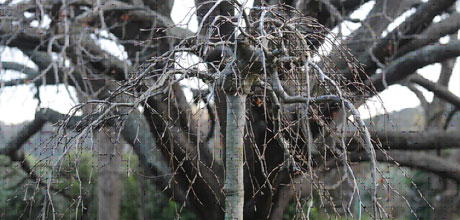Juvenile Specimens Show Benefits of Care
This article was first published on 16 Jun 2011.

Juvenile specimens
In the western lawns of the lower botanic garden, amongst the arboretum of giant trees, you’ll find a collection of younger, smaller trees. These are called the juvenile specimen trees.
Nice to be referred to as juvenile when your average age is about thirty, this is a hint that these trees can live for well over a hundred years.
Several of the young trees are forms of deciduous European beech, Fagus sylvatica. They have shed their concealing layer of leaves and have been exposed for the winter. The beauty of their strong structure and intricate patterns is now completely revealed.
Winter pruning
With such a revealing nature, it becomes very clear how important the task of early formative pruning is.
Now is a good time of year to do deciduous tree pruning. Small accurate cuts heal quickly and cleanly. Always maintain a small stub incorporating the ‘bark ridge’ when cutting larger laterals off to a main trunk. Consider the overall shape you want to achieve then, as needed, remove double leaders, unbalanced and damaged growth. Remember that wide angled laterals are much stronger and very narrow angles should be removed.
A view from a distance
The cumulative effect of a balanced crown, showing form and structure, enhanced with the longer shadows of winter, can make for a magic moment.
Identifying juvenile Fagus from a distance is easy - Fagus sylvatica 'Dawyck' has an upright or fastigate form, compared to the weeping Fagus sylvatica 'Purpurea Pendula', pictured.
Marianne Groothuis is Camellia and Theme Border Collection Curator at Dunedin Botanic Garden


